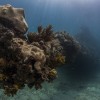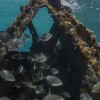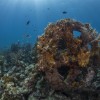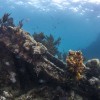I met up with the Submerged Resources Center (SRC) folks at the end of my stay in Biscayne National Park. The SRC and the Southeast Archeological Center (SEAC) folks were wrapping up their work documenting several wrecks. The SRC and SEAC had teamed up for their archeological work in Biscayne as well as for our upcoming project in Dry Tortugas. With the completion of their project in Biscayne, we loaded the suburban, hitched up the Cal Cummins and began the drive to Key West!
Our destination in Key West was The Fort Jefferson, a ship stationed at the Key West Coast Guard Station. The name for the ship comes from the fort on Dry Tortugas National Park, which is the Fort Jefferson, so to avoid confusion we referred to the ship as the Fort Jeff. I hadn’t spent much significant time on a ship this large; with three engines and two generators, this was definitely a big ship! The rest of our travel day was spent unloading the vehicles, loading up the Fort Jeff and hitching our boat, the Cal, to the Fort Jeff for towing purposes. I was geeking out by all of the Coast Guard ships at the dock, which were beautifully lit by the sunset.
That night we stayed on the Fort Jeff, and I fell asleep to the gentle rocking of the ship. In the morning we were joined by Dave Conlin, Brett Seymour, and David Morgan of SEAC. With that our numbers were complete, and we began the four-hour trip to Dry Tortugas National Park!
Our goal for this project is to survey, stabilize and photograph two wrecks, the Cement Barrel site and the Single Deck site. Both sites had been surveyed and mapped in the mid ’90s, however hurricanes and time have deteriorated the wrecks, necessitating further mapping and documentation.
Our arrival at the park was met by excitement all around- the Dry Tortugas is so remote that it was the first time that some of our company had seen it, myself included. For others it had been years since they’d last visited. After unloading and organizing our gear for the next day we got to explore the park, which felt like stepping back into the past. You could almost hear the call to muster from the grounds!
The next day was splashdown day, as we set sail to perform site assessments. The first diving day of each project is generally used to scope out the site and to get a feel for the diving in the park. The weather was a little choppy for our first day of diving, but the dives were spectacular. Because of the park’s inaccessibility the wildlife is able to thrive unmolested, resulting in huge schools of fish congregating over the wrecks. Plus, Dry Tortugas is a wreck mecca, with gorgeous wrecks just minutes from the park.
- Windjammer/Avanti shipwreck
- Windjammer/Avanti shipwreck
- Windjammer/Avanti shipwreck
- Windjammer/Avanti shipwreck
- Ship machinery on Pulaski Shoal
- Windjammer/Avanti shipwreck
One of Dave’s pithy sayings is “the weather you have today is the weather you’ll wish you had tomorrow.” That was true for our second day on the water, because the following morning I woke up at three a.m. to the ship rocking back and forth. A squall blew through, and we delayed our diving operations until noon.
Once the weather cleared up we were joined by Jasmine Baloch, an intern at the park and University of Miami graduate student who specializes in lionfish removal. Brett, Jasmine and I hopped aboard the Cal, or the “art boat,” as it was dubbed by the rest of the team. Since we had two boats to use for the project, Brett and I were able to focus on photographic research on the Cal, while the rest of the team did their archeological work on another boat, the Parker. My main task was to be Brett’s dive buddy as he took still images for a reverse photogrammetry program that would create 3D models. After Brett was done I would hop back in the water with Jasmine to photograph the same wreck myself.
Over the following few days we were also joined by Kayla Nimmo, a Biological Science Technician at the park, Chris Muina, another lionfish intern and University of Miami graduate student, and Elissa Connolly-Randazzo, a Student Conservation Association (SCA) intern. Chris and Elissa made spearing lionfish look easy, and it was great to meet and chat to other young professionals in the marine science field.
Even though I was exhausted at the end of each day, I tried to make the most of my time at the park by watching the sunset or snorkeling in the late afternoon. There was a trio of goliath groupers living underneath the dock, so one evening I went snorkeling with Jess to try to coax them out for a photo. They were only too happy to oblige! Curious, the huge groupers swam right up to us; they had nothing to fear, as the largest one was larger than us!
And if my experiences thus far weren’t awe-inspiring enough, the highlight of my visit to Dry Tortugas happened the morning of my departure from the island. I woke up at 5:30 a.m. and joined Kayla, Jasmine, Chris and their University of Miami advisors to watch sea turtle nesting monitoring on East Key, a small island near the fort. Kayla goes to East Key every three to four days to check on the Loggerhead nests, and the Lionfish and SCA interns monitor the nests as well. By keeping a detailed log of when each nest was laid and by monitoring each nest for tracks, Kayla and the interns are able to know when each nest hatches. After they’re certain that a nest has hatched, they dig up the nest to count the number of eggshells and look for any stragglers that didn’t make it out.
It was such an incredible experience to watch Chris, Jasmine and Kayla dig up the baby sea turtles, especially knowing that without their help the remaining stragglers wouldn’t have made it to the ocean. Seeing the turtles emerge from their nests will be a memory I hope to keep forever! That, combined with the gorgeous wrecks in the crystal clear water made Dry Tortugas a magical place to visit.
The sea turtle monitoring program at Dry Tortugas National Park is conducted in accordance with Florida Fish and Wildlife Conservation Commission (FWC) marine turtle permit #0187. All species of marine turtles are either threatened or endangered and it is illegal to harass, harm, pursue, hunt, shoot, wound, kill, trap, capture, or collect these or other protected species. Please contact the primary permit holder, Kayla Nimmo (Kayla_Nimmo@nps.gov) with any questions or concerns.




















Another great story about one of my favorite places. Thanks for bringing these places to life for folks who can’t get to them.